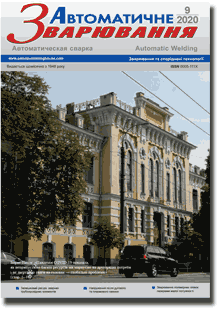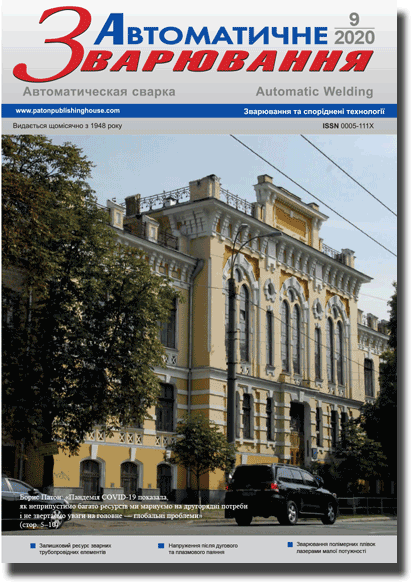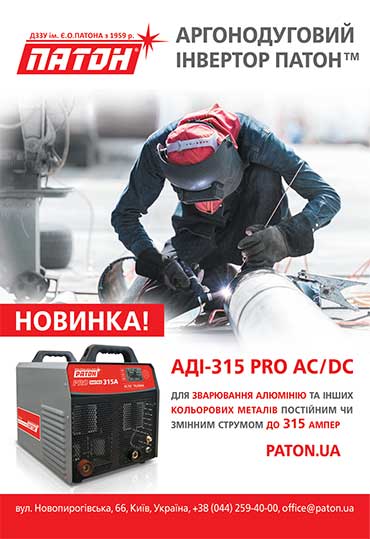| 2020 №09 (08) |
DOI of Article 10.37434/as2020.09.01 |
2020 №09 (02) |

"Avtomatychne Zvaryuvannya" (Automatic Welding), #9, 2020, pp. 11-21
Numerical methodology of prediction of the reliability and residual life of welded pipeline elements with corrosion-erosion defects
O.S. Milenin, O.A. Velikoivanenko, G.P. Rozynka, N.I. Pivtorak
E.O. Paton Electric Welding Institute of the NAS of Ukraine. 11 Kazymyr Malevych Str., 03150, Kyiv, Ukraine. E-mail: office@paton.kiev.ua
A set of procedures, mathematical models and tools for their finite-element realization were developed, to solve typical practical tasks of expert analysis of the technological condition and residual safe operating life of welded elements of the main and technological pipelines with defects of corrosion-erosion metal loss detected during diagnostics. In order to lower the conservativeness of analysis, the inter-related processes of thermal deformation at erection and repair welding, as well as initiation and propagation of subcritical damage of the defective structure material by the ductile mode in operation under complicated temperature-force conditions of external impact, were taken into account. Procedures of statistical analysis of fracture susceptibility of welded pipelines were developed on the base of Weibull and Monte-Carlo methods, and adequacy of the developed computational methods was confirmed. Peculiarities of the effect of welding on the reliability and serviceability of the main and technological pipelines with detected defects of corrosion-erosion metal loss were determined, in order to develop minimally conservative recommendations as to the possibility of safe operation of the pipelines. 18 Ref., 2 Tabl., 12 Fig.
Keywords: pipeline, defect of corrosion-erosion metal loss, welded joint, limit state, reliability, fracture probability, ductile fracture
Received: 19.08.2020
References
1. Lemaitre, J., Desmorat, R. (2005) Engineering Damage Mechanics. Ductile, Creep, Fatigue and Brittle Failures. Berlin, Springer-Verlag. https://doi.org/10.1007/b1388822. de Geus, T.W.J., Peerlings, R.H.J., Geers, M.G.D. (2015) Microstructural modeling of ductile fracture initiation in multi- phase materials. Engineering Fracture Mechanics, 147, 318-330. https://doi.org/10.1016/j.engfracmech.2015.04.010
3. Makhnenko, V. (2013) Problems of examination of modern critical welded structures. The Paton Welding J., 5, 21-28.
4. Wei, Y., Zhang, L., Au, F.T.K. et al. (2016) Thermal creep and relaxation of prestressing steel. Construction and Building Materials, 128, 118-127. https://doi.org/10.1016/j.conbuildmat.2016.10.068
5. Velikoivanenko, E., Milenin, A., Popov, A. et al. (2019) Methods of numerical forecasting of the working performance of welded structures on computers of hybrid architecture. Cybernetics and Systems Analysis, 55, 1, 117-127. https://doi.org/10.1007/s10559-019-00117-8
6. Xue, L. (2007) Damage accumulation and fracture initiation in uncracked ductile solids subject to triaxial loading. Int. J. of Solids and Structures, 44, 5163-5181. https://doi.org/10.1016/j.ijsolstr.2006.12.026
7. Milenin, A.S., Velikoivanenko, E.A., Rozynka, G.F., Pivtorak, N.I. (2016) Simulation of subcritical damage of metal in welded pipeline elements at low-cycle loading. Tekh. Diagnost. i Nerazrush. Kontrol, 4, 14-20. https://doi.org/10.15407/tdnk2016.04.03
8. Jones, N. (2012) Structural Impact. Second edition. Cambridge University Press. https://doi.org/10.1017/CBO9780511624285
9. Lemaitre, J., Chaboche, J.-L. (1990) Mechanics of Solid Materials. Cambridge University Press. https://doi.org/10.1017/CBO9781139167970
10. Milenin, A.S., Velikoivanenko, E.A., Rozynka, G.F., Pivtorak, N.I. (2013) Simulation of processes of initiation and propagation of ductile fracture pores in welded structures. The Paton Welding J., 9, 26-31
11. Chen, Z., Butcher, C. (2013) Micromechanics Modelling of Ductile Fracture. Springer Netherlands. https://doi.org/10.1007/978-94-007-6098-1
12. Milenin, O. (2017) Numerical prediction of the current and limiting states of pipelines with detected flaws of corrosion wall thinning. Journal of hydrocarbon power engineering, 4, 1, 26-37.
13. Lindquist, E.S. (1994) Strength of materials and the Weibull distribution. Probabilistic Engineering Mechanics, 9, 3, 191-194. https://doi.org/10.1016/0266-8920(94)90004-3
14. Milenin, A., Velikoivanenko, E., Rozynka, G., Pivtorak, N. (2019) Probabilistic procedure for numerical assessment of corroded pipeline strength and operability. International J. of Pressure Vessels and Piping, 171, 60-68. https://doi.org/10.1016/j.ijpvp.2019.02.003
15. Makhnenko, V.I. (2016) Safe operating life of welded joints and assemblies of modern structures. Kiev, Naukova Dumka [in Russian].
16. Lawless, J.F. (2002) Statistical Models and Methods for Lifetime Data. John Wiley & Sons, Inc., Floboken, New Jersey. https://doi.org/10.1002/9781118033005
17. Cronin, D. (2000) Assessment of Corrosion Defects in Pipelines. PhD thesis. University of Waterloo.
18. Kitching, R., Zarrabi, K. (1982) Limit and burst pressures for cylindrical shells with part-through slots. International J. of Pressure Vessels and Piping, 10, 4, 235-270. https://doi.org/10.1016/0308-0161(82)90035-7
Advertising in this issue:
The cost of subscription/purchase order journals or individual articles
| Journal/Currency | Annual Set | 1 issue printed |
1 issue |
one article |
| TPWJ/USD | 384 $ | 32 $ | 26 $ | 13 $ |
| TPWJ/EUR | 348 € | 29 € | 24 € | 12 € |
| TPWJ/UAH | 7200 UAH | 600 UAH | 600 UAH | 280 UAH |
| AS/UAH | 1800 UAH | 300 UAH | 300 UAH | 150 UAH |
| AS/USD | 192 $ | 32 $ | 26 $ | 13 $ |
| AS/EUR | 180 € | 30 € | 25 € | 12 € |
| SEM/UAH | 1200 UAH | 300 UAH | 300 UAH | 150 UAH |
| SEM/USD | 128 $ | 32 $ | 26 $ | 13 $ |
| SEM/EUR | 120 € | 30 € | 25 € | 12 € |
| TDNK/UAH | 1200 UAH | 300 UAH | 300 UAH | 150 UAH |
| TDNK/USD | 128 $ | 32 $ | 26 $ | 13 $ |
| TDNK/EUR | 120 € | 30 € | 25 € | 15 € |
AS = «Automatic Welding» - 6 issues per year;
TPWJ = «PATON WELDING JOURNAL» - 12 issues per year;
SEM = «Electrometallurgy Today» - 4 issues per year;
TDNK = «Technical Diagnostics and Non-Destructive Testing» - 4 issues per year.








